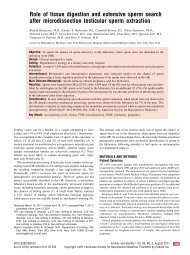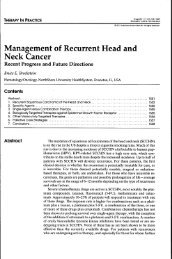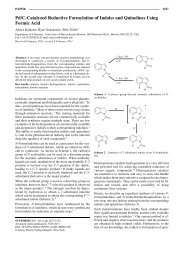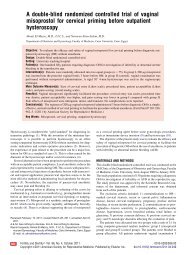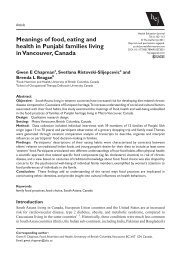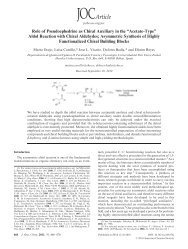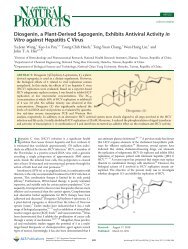A New Method for the Preparation of (E)-2-(Styrylsulfonyl)acetic Acid ...
A New Method for the Preparation of (E)-2-(Styrylsulfonyl)acetic Acid ...
A New Method for the Preparation of (E)-2-(Styrylsulfonyl)acetic Acid ...
You also want an ePaper? Increase the reach of your titles
YUMPU automatically turns print PDFs into web optimized ePapers that Google loves.
SHORT PAPER 1205<br />
A <strong>New</strong> <strong>Method</strong> <strong>for</strong> <strong>the</strong> <strong>Preparation</strong> <strong>of</strong> (E)-2-(<strong>Styrylsulfonyl</strong>)<strong>acetic</strong> <strong>Acid</strong> Esters<br />
and Their Reactions with Hydrazine Hydrate<br />
(E)-2-(<strong>Styrylsulfonyl</strong>)<strong>acetic</strong> Son <strong>Acid</strong> Esters T. Nguyen, Norton P. Peet*<br />
Microbiotix, Inc., One Innovation Drive, Worcester, MA 01605, USA<br />
Fax +1(508)7571999; E-mail: npeet@microbiotix.com<br />
Received 18 December 2010; revised 18 February 2011<br />
Abstract: A new route to esters <strong>of</strong> (E)-2-(styrylsulfonyl)<strong>acetic</strong> acid<br />
has been developed. Treatment <strong>of</strong> <strong>the</strong> methyl ester with hydrazine<br />
hydrate gave <strong>the</strong> six-membered 4-amino-5-phenylthiomorpholine-<br />
3-one 1,1-dioxide (1), and not <strong>the</strong> seven-membered 6-phenyl-1,4,5thiadiazepane-3-one<br />
1,1-dioxide (2) as previously described by o<strong>the</strong>rs.<br />
In contrast, treatment <strong>of</strong> <strong>the</strong> ethyl ester with <strong>the</strong> same reagent<br />
provided a separable 1:1.2 mixture <strong>of</strong> 1 and 2. The NMR spectra <strong>of</strong><br />
both 1 and 2 differed substantially from that described <strong>for</strong> 2 in <strong>the</strong><br />
previous report.<br />
Key words: cyclizations, sulfones, heterocycles, esters<br />
In <strong>the</strong> course <strong>of</strong> our literature survey on diazepanes, we<br />
were intrigued by a recently reported syn<strong>the</strong>sis <strong>of</strong> 6-phenyl-1,4,5-thiadiazepan-3-one<br />
1,1-dioxide (2). Padmavathi<br />
and co-workers reported that dioxide 2 was produced by<br />
treatment <strong>of</strong> methyl (E)-2-(styrylsulfonyl)acetate with hydrazine<br />
hydrate in refluxing methanol. 1 The reported <strong>for</strong>mation<br />
<strong>of</strong> this seven-membered ring was somewhat<br />
surprising to us, because previous experience seemed to<br />
indicate that reactions <strong>of</strong> hydrazine with 1,5-dielectrophiles<br />
strongly favors <strong>the</strong> <strong>for</strong>mation <strong>of</strong> <strong>the</strong> six-memberedring<br />
adducts. 2 Fur<strong>the</strong>rmore, an examination <strong>of</strong> Padmavathi’s<br />
1H NMR data rein<strong>for</strong>ced our concerns, in that one<br />
broad singlet at d = 10.58 ppm was assigned to two NH<br />
protons. A single peak <strong>for</strong> both <strong>of</strong> <strong>the</strong>se protons is not<br />
what one would expect, because <strong>the</strong> two NH groups in 2<br />
are quite different. We suspected that <strong>the</strong> product might be<br />
<strong>the</strong> isomeric six-membered 4-amino-5-phenylthiomorpholine-3-one<br />
1,1-dioxide (1), <strong>the</strong> NH2 protons <strong>of</strong> which<br />
would be expected to appear as a broad singlet. However,<br />
a value <strong>of</strong> d = 10.58 ppm would be too high <strong>for</strong> such an<br />
amino group by comparison with some known analogues<br />
(Figure 1). 2c,3 Because we were unable to contact <strong>the</strong> author,<br />
we decided to reinvestigate this reaction experimentally<br />
to check <strong>the</strong> identity <strong>of</strong> <strong>the</strong> product.<br />
Padmavathi and co-workers did not report any experimental<br />
procedure <strong>for</strong> <strong>the</strong> preparation <strong>of</strong> <strong>the</strong>ir starting material,<br />
methyl (E)-2-(styrylsulfonyl)acetate (6). The most closely<br />
related substrate that has appeared in <strong>the</strong> literature is (E)-<br />
2-(4-methylstyrylsulfonyl)<strong>acetic</strong> acid, which was prepared<br />
by Bhaskar Reddy and co-workers from sodium<br />
(E)-4-methylstyrylsulfinate and chloro<strong>acetic</strong> acid. 4 Our<br />
attempts to follow this route were unsuccessful because <strong>of</strong><br />
SYNTHESIS 2011, No. 8, pp 1205–1207xx.xx.2011<br />
Advanced online publication: 25.03.2011<br />
DOI: 10.1055/s-0030-1259974; Art ID: M54610SS<br />
© Georg Thieme Verlag Stuttgart · <strong>New</strong> York<br />
a lack <strong>of</strong> experimental details <strong>for</strong> <strong>the</strong> preparation <strong>of</strong> sodium<br />
(E)-4-methylstyrylsulfinate. This problem prompted<br />
us to design a new and more reliable syn<strong>the</strong>sis <strong>of</strong> methyl<br />
ester 6 and its analogues from <strong>the</strong> readily commercially<br />
available starting materials methyl sulfanylacetate, diethyl<br />
(chloromethyl)phosphonate, and benzaldehyde.<br />
Ph<br />
N<br />
O<br />
Figure 1<br />
MeO<br />
RO<br />
Scheme 1<br />
O O<br />
S<br />
N<br />
RO<br />
NH 2<br />
N<br />
R<br />
O<br />
NH2<br />
Ph<br />
O O<br />
S<br />
N<br />
H<br />
1 2<br />
O O O O<br />
H 3<br />
Me 4<br />
5 Ph<br />
O O<br />
S P<br />
S P<br />
OEt<br />
OEt<br />
NH<br />
The syn<strong>the</strong>sis began with treatment <strong>of</strong> methyl sulfanylacetate<br />
(7) with diethyl (chloromethyl)phosphonate (8) to<br />
give <strong>the</strong> sulfide 9 in 62% yield. Oxidation <strong>of</strong> 9 with Oxone<br />
gave <strong>the</strong> corresponding sulfone 10 in 91% yield. Treatment<br />
<strong>of</strong> 10 with benzaldehyde in <strong>the</strong> presence <strong>of</strong> triethylamine<br />
and lithium bromide gave methyl ester 6 in 41%<br />
yield. The corresponding ethyl ester 13 could also be conveniently<br />
prepared in good yield by <strong>the</strong> same route. We<br />
believe that this route could be used to generate a library<br />
<strong>of</strong> useful compounds simply by changing <strong>the</strong> aldehyde in<br />
<strong>the</strong> last step. It was also possible to convert <strong>the</strong> methyl es-<br />
O<br />
(ppm)<br />
R δ NH2<br />
O O<br />
R = Me 91%<br />
10<br />
R = Et 96%<br />
12<br />
OEt<br />
OEt<br />
5.87<br />
5.82<br />
5.68<br />
P<br />
SH OEt<br />
Cl +<br />
OEt<br />
7 8<br />
9 R = Me<br />
11 R = Et<br />
2CO3, EtOH<br />
K<br />
95%<br />
PhCHO<br />
Et3N LiBr,<br />
MeCN<br />
K2CO3<br />
°C 60<br />
h 24<br />
62%<br />
Oxone ®<br />
MeOH, H2O<br />
Ph<br />
O<br />
S<br />
O<br />
O<br />
R = Me 41%<br />
6<br />
R = Et 77%<br />
13<br />
OR
1206 S. T. Nguyen, N. P. Peet SHORT PAPER<br />
ter 6 into <strong>the</strong> ethyl ester 13 by treatment with potassium<br />
carbonate and ethanol, albeit in a lower yield (48%).<br />
Treatment <strong>of</strong> ester 6 or 13 with hydrazine hydrate provided<br />
interesting results. The six-membered-ring product 1<br />
was obtained almost exclusively from <strong>the</strong> reaction <strong>of</strong> ester<br />
6 with hydrazine hydrate, whereas a mixture <strong>of</strong> products<br />
1 and 2 was obtained from <strong>the</strong> reaction <strong>of</strong> ester 13 with hydrazine<br />
hydrate (Scheme 2). The structures <strong>of</strong> 1 and 2<br />
were elucidated by 1H NMR, 13C NMR, and IR spectroscopy<br />
and by HRMS. The results matched our expectations<br />
in all respects. The 1H NMR spectrum <strong>of</strong> 1 showed a<br />
broad singlet <strong>for</strong> two (exchangeable) NH protons at d =<br />
4.65 ppm, whereas <strong>the</strong> spectrum <strong>of</strong> 2 showed two (exchangeable)<br />
NH signals at d = 9.42 ppm and d = 5.79 ppm.<br />
At this point, <strong>the</strong> identity <strong>of</strong> <strong>the</strong> product reported by Padmavathi<br />
and co-workers remains elusive, because <strong>the</strong><br />
NMR data in <strong>the</strong>ir report is not consistent with our NMR<br />
results <strong>for</strong> ei<strong>the</strong>r 1 or 2.<br />
Ph<br />
Ph<br />
Ph<br />
O<br />
O<br />
Scheme 2<br />
S<br />
6<br />
S<br />
13<br />
O<br />
O<br />
O<br />
S<br />
O<br />
O<br />
O<br />
NH O<br />
NH 2<br />
OMe<br />
OEt<br />
R<br />
O<br />
reaction intermediates<br />
14 R = Me or Et<br />
NH2NH2 . H2O<br />
MeOH<br />
°C 65<br />
NH2NH2 . H2O<br />
EtOH<br />
°C 65<br />
48%<br />
50%<br />
O O<br />
S<br />
Whereas we expected <strong>the</strong> <strong>for</strong>mation <strong>of</strong> <strong>the</strong> six-memberedring<br />
product, we did not expect <strong>the</strong> <strong>for</strong>mation <strong>of</strong> <strong>the</strong> sevenmembered<br />
ring, because <strong>the</strong> <strong>for</strong>mation <strong>of</strong> <strong>the</strong> six-membered<br />
ring should be entropically favored. The change in<br />
<strong>the</strong> product distribution caused by a subtle change in <strong>the</strong><br />
ester structure implies that <strong>the</strong> cyclization event occurs after<br />
<strong>the</strong> conjugate addition <strong>of</strong> hydrazine and that it is sensitive<br />
to <strong>the</strong> steric bulk <strong>of</strong> <strong>the</strong> ester moiety. On <strong>the</strong> basis <strong>of</strong><br />
our results, we predict that <strong>the</strong> reaction <strong>of</strong> <strong>the</strong> corresponding<br />
isopropyl ester should give 2 as <strong>the</strong> major product, but<br />
we did not attempt this reaction.<br />
In conclusion, we established a new and reliable route to<br />
methyl (E)-2-(styrylsulfonyl)<strong>acetic</strong> acid methyl (6) and<br />
<strong>the</strong> corresponding ethyl ester 13. 1,1-Dioxo-4-amino-5phenylthiomorpholine-3-one<br />
(1) and 1,1-dioxo-6-phenyl-<br />
1,4,5-thiadiazepan-3-one (2) were prepared and fully<br />
characterized; nei<strong>the</strong>r <strong>of</strong> <strong>the</strong>se compounds displayed<br />
Syn<strong>the</strong>sis 2011, No. 8, 1205–1207 © Thieme Stuttgart · <strong>New</strong> York<br />
Ph<br />
Ph<br />
N<br />
H<br />
2<br />
O<br />
NH<br />
S<br />
N<br />
O<br />
NH2<br />
1<br />
O<br />
1 +<br />
O<br />
(1.2:1)<br />
spectral data consistent with those previously reported <strong>for</strong><br />
compound 2 by Padmavathi and co-workers. 1<br />
All commercially obtained solvents and reagents were used as received.<br />
1 H (300 MHz) and 13 C NMR (75 MHz) spectra were recorded<br />
on a Bruker 300 MHz instrument. Chemical shifts are given as d<br />
values referenced to <strong>the</strong> internal standard TMS. Mass spectra were<br />
recorded on an Agilent ESI-TOF instrument or a Waters Micromass<br />
Quattro Ultima MS instrument, and HRMS spectra were recorded<br />
on a Bruker Daltonic High Resolution Q-FTMS instrument. FTIR<br />
spectra were recorded on a Perkin Elmer Spectrum 400 instrument.<br />
Methyl {[(Diethoxyphosphoryl)methyl]sulfanyl}acetate (9)<br />
K2CO3 (5 g, 36.2 mmol) was added to a mixture <strong>of</strong><br />
ClCH2P(O)(OEt) 2 (8; 4.94 g, 26.5 mmol) and HSCH2CO2Me (7; 5<br />
g, 47.1 mmol), and <strong>the</strong> mixture was stirred and heated at 70 °C <strong>for</strong><br />
24 h. The mixture was <strong>the</strong>n diluted with CH2Cl2 (20 mL), filtered,<br />
and concentrated by rotary evaporation. The residue was purified by<br />
column chromatography (silica gel, 20–50% EtOAc–hexanes) to<br />
give a colorless oil; yield: 4.22 g (62%); Rf = 0.28 (hexanes–EtOAc,<br />
1:1).<br />
1H NMR (CDCl3): d = 4.18 (m, 4 H), 3.74 (s, 3 H), 3.50 (s, 2 H),<br />
2.89 (d, J = 12.9 Hz, 2 H), 1.35 (t, J = 7.2 Hz, 6 H).<br />
13C NMR (CDCl3): d = 170.4, 62.7, 52.4, 33.6, 24.8 (d, J = 149 Hz),<br />
16.5.<br />
HRMS (ESI): m/z [M + H] + calcd <strong>for</strong> C8H18O5PS: 257.0607; found:<br />
257.0613.<br />
Ethyl {[(Diethoxyphosphoryl)methyl]sulfanyl}acetate (11)<br />
K2CO3 (15 mg, 0.1 mmol) was added to a soln <strong>of</strong> ester 9 (1.78 g, 6.9<br />
mmol) in EtOH (15 mL), and <strong>the</strong> mixture was stirred <strong>for</strong> 16 h <strong>the</strong>n<br />
filtered. The filtrate was concentrated by rotary evaporation. The<br />
residue was dissolved in CH2Cl2 (10 mL) and filtered again to remove<br />
traces <strong>of</strong> K2CO3. The filtrate was concentrated by rotary evaporation<br />
and dried in a high vacuum to give a pale yellow oil; yield:<br />
1.79 g (95%); Rf = 0.36 (hexanes–EtOAc, 1:1).<br />
1H NMR (CDCl3): d = 4.18 (m, 6 H), 3.48 (s, 2 H), 2.89 (d, J =12.9<br />
Hz, 2 H), 1.35 (t, J = 7.2 Hz, 6 H), 1.29 (t, J = 7.2 Hz, 3 H).<br />
HRMS (ESI): m/z [M + H] + calcd <strong>for</strong> C9H20O5PS: 271.1; found:<br />
271.0.<br />
Methyl {[(Diethoxyphosphoryl)methyl]sulfonyl}acetate (10);<br />
Typical Procedure<br />
A soln <strong>of</strong> Oxone (3.1 g, 5.0 mmol) in H2O (13 mL) was added dropwise<br />
to a soln <strong>of</strong> ester 9 (0.86 g, 3.35 mmol) in MeOH (10 mL) at<br />
0 °C, and <strong>the</strong> resulting suspension was allowed to warm to r.t. over<br />
1 h and <strong>the</strong>n stirred <strong>for</strong> 16 h. The white solid was removed by filtration,<br />
and <strong>the</strong> filtrate was concentrated to about 10 mL by rotary<br />
evaporation. The cloudy soln was extracted with EtOAc (4 × 30<br />
mL), and <strong>the</strong> extracts were dried (MgSO4) and concentrated by rotary<br />
evaporation. The residue was purified by gel column chromatography<br />
(silica gel, 50–75% EtOAc–hexanes) to give a colorless<br />
oil; yield: 0.88 g (91%); Rf = 0.32 (hexanes–EtOAc, 1:1).<br />
1H NMR (CDCl3): d = 4.48 (s, 2 H), 4.25 (m, 4 H), 3.95 (d, J =16.2<br />
Hz, 2 H), 3.83 (s, 3 H), 1.38 (t, J = 7.2 Hz, 6 H).<br />
13C NMR (CDCl3): d = 164.0, 63.8, 57.4, 53.3, 50.1 (d, J = 138 Hz),<br />
49.2, 16.3.<br />
HRMS (ESI): m/z [M + H] + : calcd <strong>for</strong> C8H18O7PS: 289.0505; found:<br />
289.0518.<br />
Ethyl {[(Diethoxyphosphoryl)methyl]sulfonyl}acetate (12)<br />
Ester 12 was prepared by <strong>the</strong> same procedures as above, starting<br />
from 11 (1.79 g, 6.63 mmol) and Oxone (6.11 g, 9.9 mmol).
SHORT PAPER (E)-2-(<strong>Styrylsulfonyl</strong>)<strong>acetic</strong> <strong>Acid</strong> Esters 1207<br />
Colorless oil; yield: 1.91 g (96%); R f = 0.23 (hexanes–EtOAc, 1:1).<br />
1H NMR (CDCl3): d = 4.45 (s, 2 H), 4.25 (m, 6 H), 3.95 (d, J =16.2<br />
Hz, 2 H), 1.40–1.30 (m, 9 H).<br />
MS (ESI): m/z [M + H] + calcd <strong>for</strong> C9H20O7PS: 303.1; found: 303.0.<br />
Methyl (E)-2-(<strong>Styrylsulfonyl</strong>)acetate (6); Typical Procedure<br />
LiBr (0.38 g, 4.41 mmol) was added to a soln <strong>of</strong> ester 10 (0.85 g,<br />
2.94 mmol), PhCHO (0.33 mL, 3.2 mmol), and Et3N (1.23 mL, 9.7<br />
mmol) in MeCN (7 mL). The resulting suspension was stirred <strong>for</strong><br />
16 h at r.t. and <strong>the</strong>n diluted with MeCN (10 mL). The white solid<br />
was removed by filtration and rinsed with MeCN (5 mL). The combined<br />
organic phases were concentrated by rotary evaporation and<br />
<strong>the</strong> residue was purified by column chromatography (silica gel, 25–<br />
50% EtOAc–hexanes) to give a waxy solid; yield: 0.29 g (41%);<br />
Rf = 0.52 (hexanes–EtOAc, 1:1).<br />
1H NMR (CDCl3): d = 7.64 (d, J = 15.6 Hz, 1 H), 7.56–7.53 (m, 2<br />
H), 7.47–7.43 (m, 3 H), 7.07 (d, J = 15.6 Hz, 1 H), 4.10 (s, 2 H),<br />
3.82 (s, 3 H).<br />
13C NMR (CDCl3): d = 163.4, 145.8, 132.0, 131.7, 129.2, 128.8,<br />
124.5, 59.9, 53.3.<br />
MS (ESI): m/z [M + Na] + calcd <strong>for</strong> C11H12NaO4S: 263.0; found:<br />
263.1.<br />
Ethyl (E)-2-(<strong>Styrylsulfonyl</strong>)acetate (13)<br />
Ester 13 was prepared by using <strong>the</strong> same procedures as above, starting<br />
from 12 (1.0 g, 3.3 mmol), PhCHO (0.37 mL, 3.6 mmol), Et3N (0.69 mL, 4.95 mmol), and LiBr (0.43 g, 4.95 mmol).<br />
Viscous colorless oil; yield: 0.65 g (77%); Rf = 0.61 (hexanes–<br />
EtOAc, 1:1).<br />
1H NMR (CDCl3): d = 7.65 (d, J=15.3 Hz, 1 H), 7.56–7.53 (m, 2<br />
H), 7.48–7.43 (m, 3 H), 7.06 (d, J = 15.3 Hz, 1 H), 4.25 (q, J =7.2<br />
Hz, 2 H), 4.09 (s, 2 H), 1.29 (t, J = 7.2 Hz, 3 H).<br />
MS (ESI): m/z [M + H] + calcd <strong>for</strong> C12H15O4S: 255.1; found: 255.0.<br />
4-Amino-5-phenylthiomorpholine-3-one 1,1-Dioxide (1); Typical<br />
Procedure<br />
N2H4·H2O (24 L, 0.50 mmol) was added to a cloudy soln <strong>of</strong> ester 6<br />
(60 mg, 0.25 mmol) in MeOH (15 mL). The mixture was heated at<br />
65 °C <strong>for</strong> 15 h and <strong>the</strong>n concentrated by rotary evaporation. The residue<br />
was purified by column chromatography (silica gel, 0–60%<br />
EtOAc–hexanes) to give a white solid; yield: 30 mg (50%); mp<br />
208–211 °C; Rf = 0.22 (hexanes–EtOAc, 1:1).<br />
FTIR (KBr): 3305.0 (m), 2984.6 (m), 2933.5 (w), 2898.2 (w),<br />
1639.1 (s), 1587.7 (s) cm –1 .<br />
1H NMR (DMSO-d6): d = 7.39–7.28 (m, 5 H, Ph), 4.85 [dd,<br />
J = 10.8, 5.1 Hz, 1 H, C(5)H], 4.80 [d, J = 15.8 Hz, 1 H, C(2)Ha], 4.65 (br s, 2 H, NH2, exch. D2O), 4.18 [dd, J = 15.8, 3.9 Hz,<br />
C(2)Hb], 3.90 [ddd, J = 14.4, 4.8, 3.9 Hz, 1 H, C(6)Ha], 3.81 [dd,<br />
J = 14.4, 10.8 Hz, 1 H, C(6)Hb]. 13C NMR (DMSO-d6): d = 160.5, 138.4, 128.5, 127.9, 127.2, 61.6,<br />
55.3, 53.6.<br />
HRMS (ESI): m/z [M + H] + calcd <strong>for</strong> C10H13N2O3S: 241.0641;<br />
found: 241.0643.<br />
6-Phenyl-1,4,5-thiadiazepan-3-one 1,1-Dioxide (2)<br />
Thiadiazepan 2 was prepared as a mixture with 1 by using <strong>the</strong> same<br />
procedures as above, starting from ester 13 (0.3 g, 1.18 mmol),<br />
N2H4·H2O (86 L, 1.77 mmol), and EtOH (30 mL).<br />
1: White solid; yield: 67 mg (24%).<br />
2: White solid; yield: 85 mg (30%); mp 194–197 °C; Rf = 0.14 (hexanes–EtOAc<br />
1:1).<br />
FTIR (KBr): 3330.6 (m), 3285.7 (m), 3003.0 (w), 2942.6 (w),<br />
1697.1 (br, vs), 1602.4 (vw), 1583.2 (vw) cm –1 .<br />
1H NMR (DMSO-d6): d = 9.42 [br s, 1 H, N(4)H, exch. D2O], 7.42–<br />
7.28 (m, 5 H, Ph), 5.79 [br s, 1 H, N(5)H, exchangeable with D2O], 5.13 [br d, J = 13.8 Hz, 1 H, C(2)Ha], 4.33 [d, J = 11.7 Hz, 1 H,<br />
C(6)H], 3.93 [dd, 1 H, J = 13.8, 11.7 Hz, C(7)Ha], 3.69 [br dd,<br />
J = 13.8, 2.4 Hz, 1 H, C(2)Hb], 3.53 [dt, J = 13.8, 2.4 Hz, 1 H,<br />
C(7)Hb]. 13C NMR (DMSO-d6): d = 165.5, 139.1, 128.6, 127.9, 126.9, 62.9,<br />
62.1, 59.6.<br />
HRMS (ESI): m/z [M + H] + calcd <strong>for</strong> C10H13N2O3S: 241.0641;<br />
found: 241.0640.<br />
Supporting In<strong>for</strong>mation <strong>for</strong> this article is available online at<br />
http://www.thieme-connect.com/ejournals/toc/syn<strong>the</strong>sis.<br />
Acknowledgment<br />
We thank Dr Helena Majgier-Baranowska, Dr Bing Li, and Dr Min<br />
Xie <strong>for</strong> <strong>the</strong>ir insightful discussions.<br />
References<br />
(1) (a) Padmavathi, V.; Thriveni, P.; Sudhakar Reddy, G.;<br />
Deepti, D. Eur. J. Med. Chem. 2008, 43, 917.<br />
(b) Padmavathi, V.; Thriveni, P.; Padmaja, A. J. Chem. Res.<br />
2004, 556.<br />
(2) (a) Peet, N. P. Syn<strong>the</strong>sis 1984, 1065. (b) Peet, N. P.; Sunder,<br />
S.; Trepanier, D. L. Indian J. Chem., Sect. B: Org. Chem.<br />
Incl. Med. Chem. 1976, 14, 701. (c) Kornet, M. J. J. Pharm.<br />
Sci. 1973, 62, 834.<br />
(3) Scheiner, P.; Frank, L.; Giusti, I.; Arwin, S.; Pearson, S. A.;<br />
Excellent, F.; Harper, A. P. J. Heterocycl. Chem. 1984, 21,<br />
1817.<br />
(4) Bhaskar Reddy, D.; Raman Reddy, P. V.; Vijayalakshmi, S.;<br />
Raman Reddy, M. V. Phosphorus, Sulfur Silicon Relat.<br />
Elem. 1993, 84, 63.<br />
Syn<strong>the</strong>sis 2011, No. 8, 1205–1207 © Thieme Stuttgart · <strong>New</strong> York



